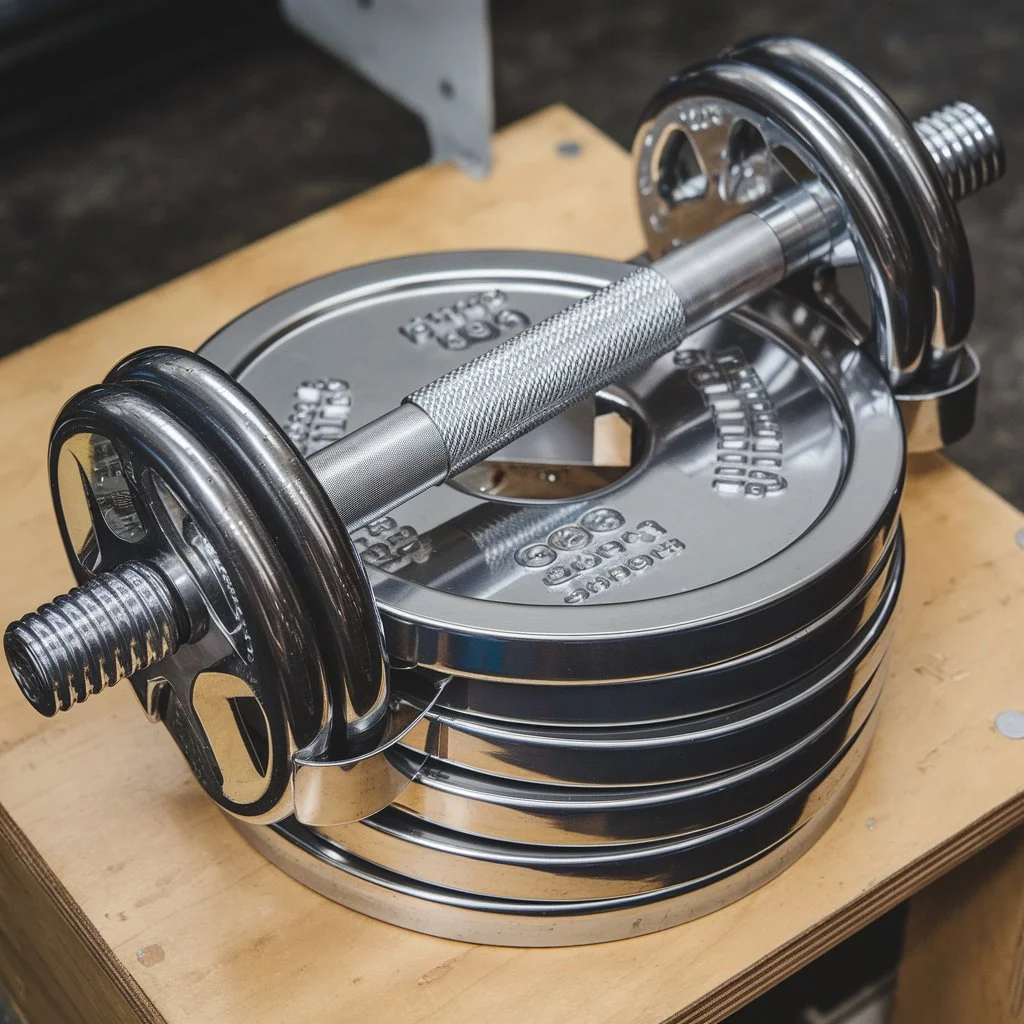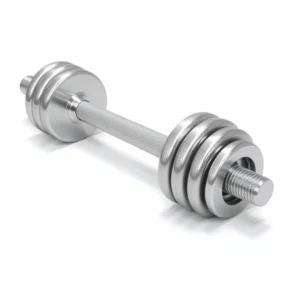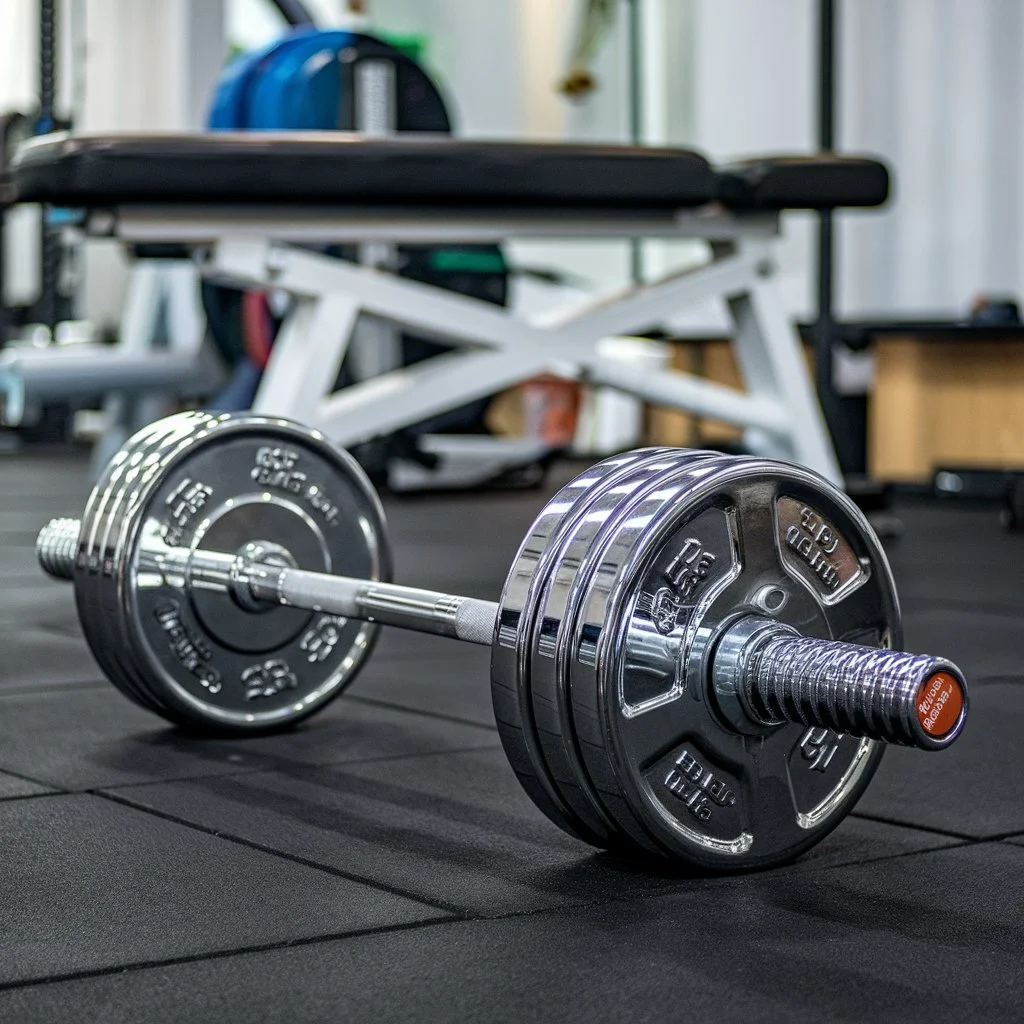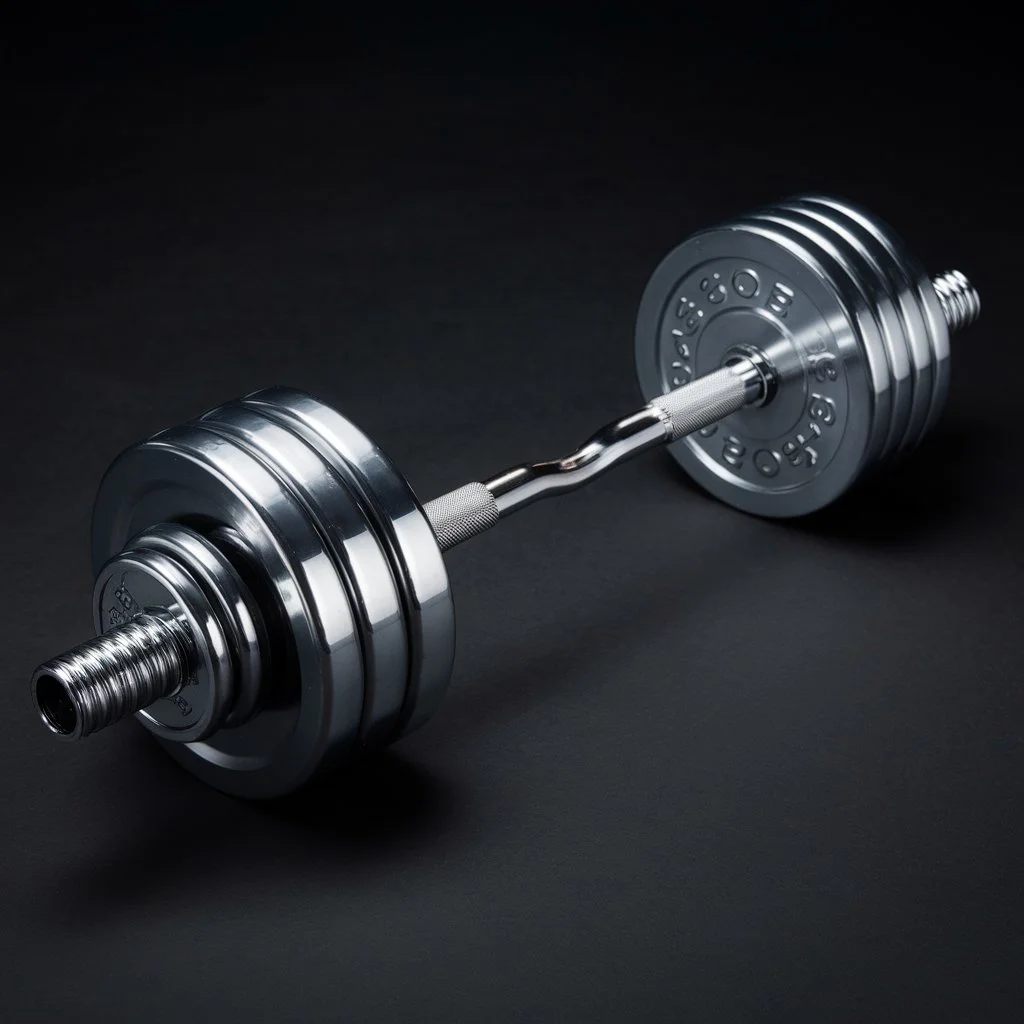Dumbbell Bars A Brief Overview
Dumbbell bars are key tools in strength training. They are versatile for many exercises that target different muscles. The bars have a simple yet effective design. They consist of a handle, often made of durable materials like steel or rubber, and weighted plates. These plates can be easily attached and removed to adjust resistance levels.
The handle is typically cylindrical in shape, providing a comfortable grip for users of all fitness levels. Dumbbell bars come in different lengths and thicknesses. They fit diverse training needs, from light toning to heavy lifting.
Dumbbell bars are adaptable. They let users do many exercises. These exercises work different muscle groups. And, they use one piece of equipment. You can target the biceps with curls. Or, sculpt the shoulders with lateral raises. You can also strengthen the chest with presses.
Dumbbell bars offer unmatched versatility for both new and experienced athletes. Also, they are compact. This makes them great for home gyms or small spaces. They let people get the benefits of strength training without bulky machines or complex setups.
The Importance of Dumbbell Bars in Strength Training
Strength training is a key part of fitness regimens. They aim to build muscle, boost strength, and improve health and function. Dumbbell bars are crucial. They provide scalable resistance tailored to each person’s fitness and goals. Unlike fixed-weight machines, they offer limited adjustability. Dumbbell bars offer a wide range of motion. This engages stabilizing muscles and promotes functional strength.
Also, dumbbell exercises mimic natural movements. They help improve coordination, balance, and proprioception. Adding dumbbell bars to their training routines can help people target muscles better. It can also help them fix muscle imbalances and cut the injury risk from repetitive motion or overreliance on machines.
Basic Components
Handle
1. Material Options
Dumbbell handles are available in various materials, each offering unique characteristics and benefits:
Steel: Steel handles are renowned for their durability and sturdiness, making them a popular choice among serious lifters. They can withstand heavy loads and are resistant to bending or warping, ensuring long-term reliability.
Chrome-Plated: Chrome-plated handles combine strength with a sleek aesthetic appeal. The chrome coating resists corrosion. It prevents rust and keeps the handle looking nice over time.
Rubber-Coated: Rubber-coated handles offer enhanced grip and comfort during workouts. The soft rubber outer layer provides a cushioned feel. It reduces strain on the hands and slipping, especially when hands get sweaty.
2. Texture and Grip Considerations
The handle’s texture and grip are important. They greatly affect the user’s comfort and performance during workouts. Key considerations include:
Knurled Texture: Many dumbbell handles feature a knurled texture, characterized by a series of diagonal or diamond-shaped indentations. This texture enhances grip. It provides traction and stops the hands from slipping, even when sweaty. The depth and aggressiveness of the knurling can vary based on personal preference and intended use.
Smooth vs. Contoured Handles: Some handles have a smooth surface, offering a sleek and comfortable grip. Others feature contoured designs with ergonomic shaping to fit the natural curvature of the hand, promoting a more secure and comfortable hold.
Grip Diameter: The diameter of the handle affects the user’s grip strength and comfort. Thicker handles need more grip strength and forearm use. They suit advanced lifters aiming to boost grip strength. Thinner handles may be preferred by those with smaller hands. They are also favored by people focusing on isolation exercises.
In the end, the choice of handle material, texture, and grip diameter depends on each person’s preferences, lifting style, and use. Each option has unique benefits for durability, comfort, and performance.
Basic Components
Bar
1. Length and Diameter Specifications
Dumbbell bars come in many lengths and diameters. This is to fit different exercises and user preferences.
Length: Standard dumbbell bars typically range from 14 inches to 18 inches in length, although custom lengths are also available. Shorter bars are for exercises that need a closer grip, like bicep curls. Longer bars offer more space for wider grips, which is good for exercises like chest presses.
Diameter: The diameter of the bar affects grip strength and comfort. The usual diameters range from 1 to 1.25 inches. Thicker bars provide more grip strength and forearm engagement. Thinner bars may be preferred for exercises requiring a lighter grip or for users with smaller hands.
2. Material Options
Dumbbell bars are made from various materials. Each has its own traits and benefits.
Solid Steel: Solid steel bars are renowned for their durability and strength. They can handle heavy loads and tough use without bending or warping. Serious lifters love them.
Hollow Steel: Hollow steel bars offer a balance between strength and weight. They are durable enough for most exercises. They are lighter and more manageable than solid steel bars. This makes them suitable for users who prioritize ease of handling.
Chrome-plated bars have a layer of chrome coating. The coating adds corrosion resistance and a sleek look. Chrome-plated bars are not as durable as solid steel. But, they offer enough strength for most users and need little upkeep.
The choice of bar material depends on factors such as intended use, budget, and personal preference. Serious lifters may choose solid steel bars. They offer the most durability and performance. Casual users may prefer hollow steel or chrome-plated bars. They are more suitable for their needs.
Basic Components
Collars
1.Purpose and Importance
Collars play a crucial role in securing weight plates onto dumbbell bars during workouts. Their main job is to stop the plates from sliding or shifting during exercises. This ensures safety and stability while lifting. Without proper collars, weight plates may come loose. They could hurt the user or damage nearby equipment.
Also, collars help spread weight evenly along the bar. This promotes balanced resistance and makes exercises more effective. Collars securely lock the plates in place. They stop imbalance and uneven loading. This allows users to focus on form and technique without distraction or concern.
2. Types
Several collar types are available for dumbbell bars. Each type has different features and ways of securing weight plates.
Spin-lock collars have a threaded collar that screws onto the end of the dumbbell bar. They press weight plates against a washer or end cap to hold them in place. Users simply twist the collar to tighten or loosen it, making it easy to adjust the weight load quickly between sets. Spin-lock collars are known for their reliability and robustness, providing a secure grip even under heavy loads.
Spring Collars: Spring collars are also known as spring clips or spring-loaded collars. They have a simple but effective design. It consists of two curved metal arms connected by a spring. To secure weight plates, users squeeze the arms together and slide the collar onto the bar until it snaps into place, gripping the plates tightly. Spring collars are easy to use. They are ideal for fast weight changes. This makes them popular among fitness fans and beginners.
Clamp collars, also called Olympic collars or barbell clamps, offer a quick and secure lock for Olympic-sized dumbbell bars. They typically feature a lever or cam mechanism that tightens a metal clamp around the bar, securing weight plates in position. Clamp collars provide great stability. They are good for heavy lifting or dynamic exercises. These exercises require minimizing plate movement.
The choice of collar type depends on factors such as bar diameter, personal preference, and intended use. Each type has unique advantages. But, all collars share one goal. They aim to ensure safety, stability, and even weight while using dumbbells.
Design Considerations
 Ergonomics
Ergonomics
1. Handle shape and diameter for comfortable grip
2. Bar length and weight distribution for balance
Durability
1. Material selection for longevity and sturdiness
2. Welding techniques for strong connections
Safety
1. Smooth edges and surfaces to prevent injuries
2. Secure collars to prevent weights from slipping off
Construction Process
Material Selection
1. Choosing High-Quality Steel for Bars and Handles
The selection of materials is a critical aspect of constructing durable and reliable dumbbell bars. They prefer high-quality steel for the bars and handles. It has exceptional strength, durability, and resistance to bending or breaking under heavy loads. When selecting steel for dumbbell construction, manufacturers consider factors such as:
Steel Grade: Choose high-strength steel. It will make sure the dumbbell bars can withstand hard use without bending or breaking. Common steel grades are used in dumbbell construction. These include carbon steel and alloy steel. They are chosen for their strong mechanical properties and performance under stress.
Manufacturing Standards are important. Following established ones ensures consistency and quality. Manufacturers may follow industry standards, such as ASTM International. They may also follow specific guidelines set by fitness equipment associations. This is to keep products safe and intact.
Implementing strict quality control helps find and fix defects in material or construction. It happens throughout the manufacturing process. This includes testing materials. It also includes checking raw steel components and verifying their dimensions. They must be accurate to meet design specs.
2. Considering Coating Options for Corrosion Resistance
Dumbbell bars need corrosion resistance. It keeps their looks and strength over time. This is especially true in moist or humid places. Coating options can add a layer of protection. They guard against rust and oxidation, extending the equipment’s lifespan. Common coating options for dumbbell bars include:
Chrome plating resists corrosion well. It also adds a sleek, polished finish. This finish makes dumbbell bars look better. The chrome layer acts as a barrier against moisture and dirt. It stops rust and corrosion from forming.
Powder coating involves applying a dry powder using static electricity to the dumbbell bars’ surface. Then, the bars are cured in an oven to form a tough finish. Powder coatings come in many colors. They resist chipping, scratching, and corrosion well. So, they work well in busy gyms.
Zinc coating, like galvanization or zinc plating, protects well. It works by forming a sacrificial barrier. This barrier stops the steel underneath from oxidizing. Zinc coatings last a long time. They protect well against rust and corrosion. They work indoors and outdoors.
By picking the right materials and coatings, manufacturers can make dumbbell bars that last for years. They will withstand the rigors of daily use and keep their looks and performance.
Construction Process
Manufacturing Steps
1. Cutting Steel Bars to Desired Lengths
The first step in making dumbbell bars is cutting steel bars. They are cut to the lengths in the design specs. Industrial-grade cutting equipment, like saws or hydraulic shears, is used to make precise cuts. It does so with minimal waste. Manufacturers measure and mark the steel bars before cutting.
They do this to ensure consistency and accuracy in the final product. Custom lengths may be needed for different dumbbell sizes or user preferences. They require precise cutting to make all the bars the same.
2. Shaping Handles for Ergonomic Grip
Once the steel bars are cut to size, the handles are shaped to provide an ergonomic grip for users. This process involves shaping the ends of the bars to form cylindrical or contoured handles that fit comfortably in the palm of the hand. Manufacturers may use special machinery. This includes lathes or CNC mills. They use these to achieve precise shaping and dimensions.
We pay attention to handle diameter, texture, and contouring. They optimize grip comfort and performance during workouts. Knurling patterns may also be added to enhance grip traction and prevent slippage, especially when hands are sweaty.
3. Welding Handles to Bars Securely
After shaping the handles, they are securely welded to the steel bars to create the complete dumbbell structure. Skilled welders use techniques such as arc welding or resistance welding. They use these techniques to join the handle and bar parts with high precision and strength. Proper alignment and positioning are critical to ensure structural integrity and stability in the finished product. Welded joints are inspected for quality and integrity, with any imperfections or defects addressed before proceeding to the next manufacturing step.
4. Adding Collars with Proper Locking Mechanisms
In the last step, we add collars to the dumbbell bars. They have locking mechanisms to keep the weight plates in place. Collars may be welded or attached using fasteners such as bolts or screws, depending on the design requirements. Manufacturers ensure that collars are tightly fastened and aligned with the bar axis.
This prevents them from shifting or loosening during use. Locks may differ. They include spin-lock collars or spring-loaded clips. The choice is based on user preferences and product specifications. We test collars for function and reliability. They must meet safety standards and grip weight plates securely.
By following these manufacturing steps with care, manufacturers make high-quality dumbbell bars. They meet performance standards and user expectations for durability, comfort, and safety.
Construction Process
Quality Control
1. Inspecting for Any Defects or Imperfections
Quality control is critical for making dumbbell bars. It ensures each meets tough standards for performance and safety. Inspection for defects starts at many stages of production. It covers many aspects of dumbbell construction, including:
Visual Inspection: Trained inspectors carefully examine each dumbbell bar for any visible defects or irregularities in shape, surface finish, or weld quality. This includes checking for cracks, dents, scratches, or inconsistencies in the handle shaping or coating.
Dimensional Accuracy: Precise measurements are taken to verify that each dumbbell bar conforms to the specified dimensions and tolerances. This ensures uniformity and consistency across multiple units, preventing variations that could affect performance or user experience.
Weld Quality: Welded joints are subjected to non-destructive testing techniques such as visual inspection, dye penetrant testing, or ultrasonic testing to detect any weld discontinuities or defects. Proper weld penetration, fusion, and reinforcement are essential for ensuring structural integrity and load-bearing capacity.
Surface Finish: The surface finish of dumbbell bars, including any coating or plating, is inspected for uniformity, adhesion, and resistance to corrosion or wear. Any blemishes or imperfections in the finish are addressed to maintain product aesthetics and longevity.
Rigorous inspections during manufacturing let manufacturers find defects or quality issues. They can fix these problems before the dumbbell bars are released.
2. Testing Durability and Balance
Inspectors visually check the bars. They also test them for durability, balance, and performance. The tests simulate workouts. Testing procedures may include:
Load Testing: Dumbbell bars are subjected to dynamic load testing using weights or resistance equipment to simulate typical usage scenarios. This testing assesses the bars’ ability to withstand repeated loading cycles without deformation, fatigue, or failure.
Drop Testing: Dumbbell bars may be subjected to drop tests from specified heights to evaluate their impact resistance and durability. This testing helps ensure that the bars can withstand accidental drops or mishandling without sustaining damage or compromising user safety.
Balance Testing: Each dumbbell bar is assessed for balance and weight distribution to ensure uniformity and consistency across multiple units. This testing helps prevent issues such as uneven loading or instability during exercises, enhancing user comfort and performance.
We analyze test results to check if they meet quality standards and specs. We address any deviations or deficiencies with corrective actions. By doing thorough quality control, manufacturers can deliver dumbbell bars. The bars meet high standards for quality, reliability, and performance. They are for fitness enthusiasts and athletes.
Conclusion
In conclusion, making dumbbell bars requires careful thought. Many key factors affect their performance and user satisfaction. The choice of high-quality materials, like steel, is just the start. Meticulous craftsmanship in shaping handles and securely welding components is also key. Each step is crucial in making durable and reliable dumbbell bars. Using top-notch materials and strict quality control is vital.
They directly impact durability, safety, and effectiveness of the equipment. Also, dumbbell bars are more versatile than just their basic construction. They can be customized to fit diverse user preferences and needs. It’s adjusting handle texture for better grip. It’s offering options for coating and collar types. Customization allows users to tailor their equipment to fit their workouts and goals. It boosts satisfaction and performance.

